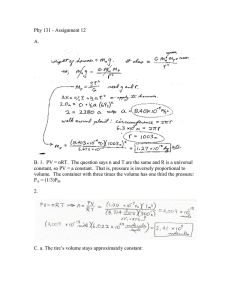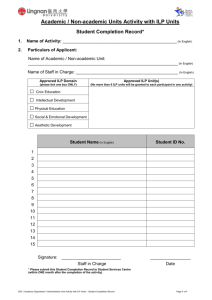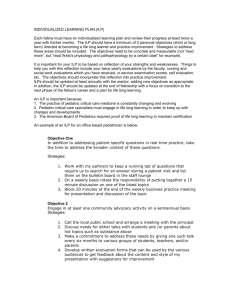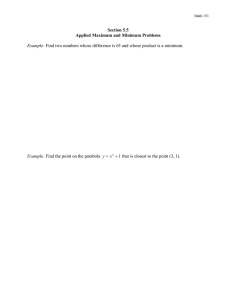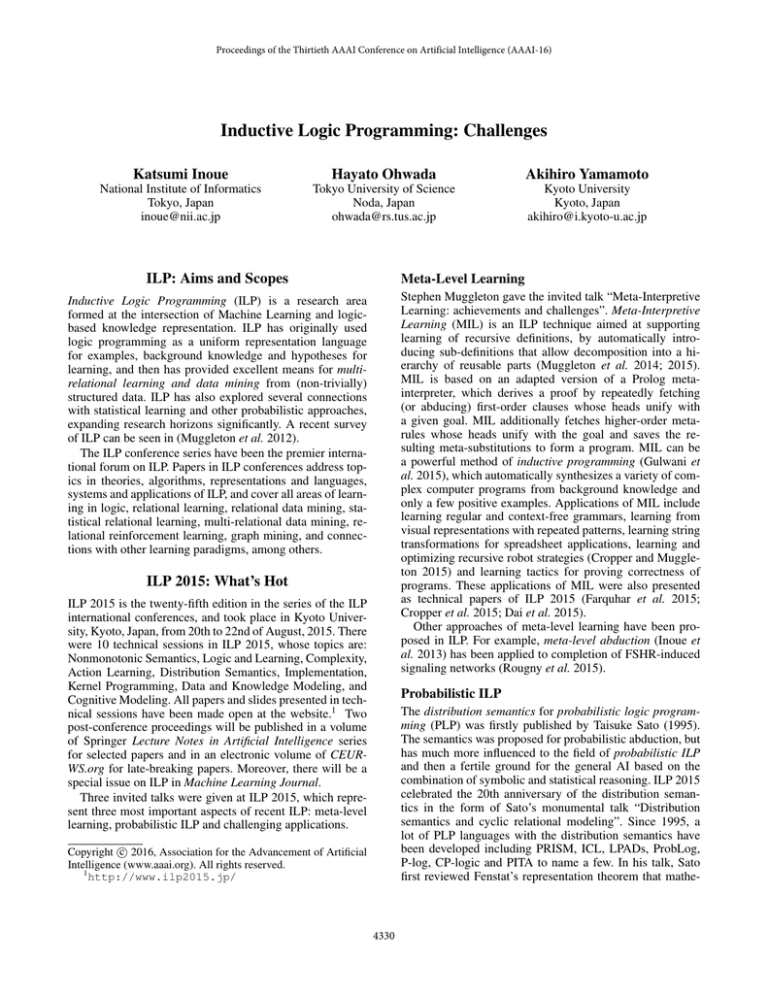
Proceedings of the Thirtieth AAAI Conference on Artificial Intelligence (AAAI-16)
Inductive Logic Programming: Challenges
Katsumi Inoue
Hayato Ohwada
Akihiro Yamamoto
National Institute of Informatics
Tokyo, Japan
inoue@nii.ac.jp
Tokyo University of Science
Noda, Japan
ohwada@rs.tus.ac.jp
Kyoto University
Kyoto, Japan
akihiro@i.kyoto-u.ac.jp
ILP: Aims and Scopes
Meta-Level Learning
Stephen Muggleton gave the invited talk “Meta-Interpretive
Learning: achievements and challenges”. Meta-Interpretive
Learning (MIL) is an ILP technique aimed at supporting
learning of recursive definitions, by automatically introducing sub-definitions that allow decomposition into a hierarchy of reusable parts (Muggleton et al. 2014; 2015).
MIL is based on an adapted version of a Prolog metainterpreter, which derives a proof by repeatedly fetching
(or abducing) first-order clauses whose heads unify with
a given goal. MIL additionally fetches higher-order metarules whose heads unify with the goal and saves the resulting meta-substitutions to form a program. MIL can be
a powerful method of inductive programming (Gulwani et
al. 2015), which automatically synthesizes a variety of complex computer programs from background knowledge and
only a few positive examples. Applications of MIL include
learning regular and context-free grammars, learning from
visual representations with repeated patterns, learning string
transformations for spreadsheet applications, learning and
optimizing recursive robot strategies (Cropper and Muggleton 2015) and learning tactics for proving correctness of
programs. These applications of MIL were also presented
as technical papers of ILP 2015 (Farquhar et al. 2015;
Cropper et al. 2015; Dai et al. 2015).
Other approaches of meta-level learning have been proposed in ILP. For example, meta-level abduction (Inoue et
al. 2013) has been applied to completion of FSHR-induced
signaling networks (Rougny et al. 2015).
Inductive Logic Programming (ILP) is a research area
formed at the intersection of Machine Learning and logicbased knowledge representation. ILP has originally used
logic programming as a uniform representation language
for examples, background knowledge and hypotheses for
learning, and then has provided excellent means for multirelational learning and data mining from (non-trivially)
structured data. ILP has also explored several connections
with statistical learning and other probabilistic approaches,
expanding research horizons significantly. A recent survey
of ILP can be seen in (Muggleton et al. 2012).
The ILP conference series have been the premier international forum on ILP. Papers in ILP conferences address topics in theories, algorithms, representations and languages,
systems and applications of ILP, and cover all areas of learning in logic, relational learning, relational data mining, statistical relational learning, multi-relational data mining, relational reinforcement learning, graph mining, and connections with other learning paradigms, among others.
ILP 2015: What’s Hot
ILP 2015 is the twenty-fifth edition in the series of the ILP
international conferences, and took place in Kyoto University, Kyoto, Japan, from 20th to 22nd of August, 2015. There
were 10 technical sessions in ILP 2015, whose topics are:
Nonmonotonic Semantics, Logic and Learning, Complexity,
Action Learning, Distribution Semantics, Implementation,
Kernel Programming, Data and Knowledge Modeling, and
Cognitive Modeling. All papers and slides presented in technical sessions have been made open at the website.1 Two
post-conference proceedings will be published in a volume
of Springer Lecture Notes in Artificial Intelligence series
for selected papers and in an electronic volume of CEURWS.org for late-breaking papers. Moreover, there will be a
special issue on ILP in Machine Learning Journal.
Three invited talks were given at ILP 2015, which represent three most important aspects of recent ILP: meta-level
learning, probabilistic ILP and challenging applications.
Probabilistic ILP
The distribution semantics for probabilistic logic programming (PLP) was firstly published by Taisuke Sato (1995).
The semantics was proposed for probabilistic abduction, but
has much more influenced to the field of probabilistic ILP
and then a fertile ground for the general AI based on the
combination of symbolic and statistical reasoning. ILP 2015
celebrated the 20th anniversary of the distribution semantics in the form of Sato’s monumental talk “Distribution
semantics and cyclic relational modeling”. Since 1995, a
lot of PLP languages with the distribution semantics have
been developed including PRISM, ICL, LPADs, ProbLog,
P-log, CP-logic and PITA to name a few. In his talk, Sato
first reviewed Fenstat’s representation theorem that mathe-
c 2016, Association for the Advancement of Artificial
Copyright Intelligence (www.aaai.org). All rights reserved.
1
http://www.ilp2015.jp/
4330
matically relates probability to first-order logic. Any consistent probability assignment should be based on the possible
worlds with a probability distribution, and the distribution
semantics gives a way for it. The semantics starts with a
simple computable distribution and transforms it to a complex one based on the semantics of logic programs. PRISM
is the first implementation of the distribution semantics with
the ability of parameter learning for probabilistic modeling
(Sato and Kameya 2001). PRISM and other PLP languages
are powerful enough to deal with recursively defined infinite
models such as Markov chains with infinitely many transitions and probabilistic context free grammars with infinitely
many sentence derivations, since these models often require
to compute an infinite sum of probabilities. The latest development of PRISM enables us to compute this infinite sum of
probabilities using cyclic propositional formulas and the EM
algorithm (Sato and Mayer 2014). A promising application
of such infinite computation in cyclic relational modeling is
plan recognition from partial observations (Sato and Kojima
2015). After Sato’s talk in ILP 2015, Fabrizio Riguzzi and
his group showed several extended topics based on the distributed semantics, e.g., (Riguzzi et al. 2015).
etc. Modeling includes learning as a part, in particular in areas such as biology, robotics and cognition. Paramonov et
al. (2015) have shown that a variety of relational query and
graph mining problems can be modeled and solved with a
variation of answer set programming (ASP).
Other Directions
Robot learning has been a very active topic in recent ILP.
Sammut et al. (2015) have shown their ongoing work on a
“robot engineer”, which enables a closed-loop design, manufacture and testing in the domain of engineering. Learning from time-series data, e.g., learning from interpretation transition (Inoue et al. 2014), and learning from both
discrete and continuous data are also hot topics in biological and other applications, e.g., (Ribeiro et al. 2015;
Srinivasan et al. 2015).
New theories and applications of ILP have also been proposed. For example, both learning logics (Sakama et al.
2015) and learning proofs and strategies (Ho et al. 2015;
Farquhar et al. 2015) perform meta-logical learning. These
logical works are particularly suitable for ILP applications.
Kuželka et al. (2015) have shown how to construct a Markov
logic network from first-order default rules such that MAP
inference from it correspond to default reasoning.
Challenging Applications
Luc De Raedt reported in his invited talk “Applications of
Probabilistic Logic Programming” on recent progress in applying PLP to challenging applications. De Raedt firstly
looked back on Winograd’s SHRDLU and reinterpreted its
tasks with modern AI technologies. Now is the time to remove the assumptions of SHRDLU such as perfect knowledge about the world and deterministic actions and to bridge
the gap between low-level perception and high-level reasoning. The real robot tasks need to deal with structured environments such as objects and their relationships as well
as the background knowledge, and cope with uncertainty to
learn from data. The details of robot grasping based on relational kernels (Frasconi et al. 2014) with numerical features was presented by Antanas et al. (2015). By extending
the distribution semantics to cope with dynamics and continuous distributions, learning multi-relational object affordances has also been developed to specify the conditions under which actions can be applied on some objects (Moldovan
et al. 2012; Nitti et al. 2013). Other recent applications of
PLP include the PheNetic system (De Maeyer et al. 2015),
which extracts the sub-network that best explains genes prioritized through a molecular profiling experiment from an
interactome, and the problem of machine reading in CMU’s
Never-Ending Language Learning, which uses ProbFOIL
(De Raedt et al. 2015) as an extension of the traditional rulelearning system FOIL with the distribution semantics.
ILP 25 Years: What’s Next
To celebrate the 25th anniversary of ILP conference series,
ILP 2015 organized a panel discussion on past and future
progress of ILP. The panelists were Stephen Muggleton,
Fabrizio Riguzzi, Filip Zelezny, Gerson Zaverucha, Jesse
Davis, Katsumi Inoue, who are all chairs of the last five
years of ILP conferences (2011–2015), and Taisuke Sato.
The discussion at the last panel held at ILP 2010 has been
summarized as the survey paper (Muggleton et al. 2012), in
which several future perspectives at that time were shown.
Since then, the areas related to Machine Learning and AI
have been rapidly growing and changing. Recent trends include learning from big data, from statistical learning to
deep learning, integration of neural and symbolic learning,
general intelligence, etc. The panel “ILP 25 Years” then considered what ILP could contribute to these recent changes.
Panelists gave their own views of recent trends of ILP for
these five years and perspective on “What next for ILP”.
Muggleton claimed that integration of learning, perception and action are important, and social skills should be
learned in human-like computing. Zelezny argued inspiration from deep learning, in the context of predicate invention and lifted neural networks. Riguzzi predicted a stronger
connection to the Semantic Web and Linked Open Data. Zaverucha considered that big data may need more techniques
for propositionalization and parallelism. Davis noticed a future trend that learns from very few examples and lots of
(commonsense) knowledge. Inoue mentioned learning from
state transitions with lots of fluents and learning with general intelligence. Finally, Sato told us the importance of ILP
that should exploit millions of propositions learned from big
data. All believe that advances of innovative techniques for
ILP as well as new challenges will give significant impacts
on many fields of AI and Machine Learning.
Declarative Modeling
Two best student paper awards of ILP 2015 were given to
Golnoosh Farnadi for the paper (Farnadi et al. 2015) and
Francesco Orsini for the paper (Orsini et al. 2015). Both
works are related to declarative modeling, the concept proposed by De Raedt, and probabilistic ILP. In fact, some
declarativeness can be seen everywhere in any domain in
the forms of constraints, graphs, actions, kernels, ontologies,
4331
References
Stephen Muggleton, Luc De Raedt, David Poole, Ivan
Bratko, Peter Flach, Katsumi Inoue, and Ashwin Srinivasan.
2012. ILP turns 20—biography and future challenges. Machine Learning 86: 3–22.
Stephen Muggleton, Dianhuan Lin, Niels Pahlavi, and
Alireza Tamaddoni-Nezhad. 2014. Meta-interpretive learning: application to grammatical inference. Machine Learning 94: 25–49.
Stephen Muggleton, Dianhuan Lin, and Alireza TamaddoniNezhad. 2015. Meta-interpretive learning of higher-order
dyadic datalog: predicate invention revisited. Machine
Learning 100: 49–73.
Davide Nitti, Tinne De Laet, and Luc De Raedt. 2013. A
particle filter for hybrid relational domains. In Proceedings
of IEEE/RSJ International Conference on Intelligent Robots
and Systems (IROS 2013), pp.2764–2771. IEEE.
Francesco Orsini, Paolo Frasconi, and Luc De Raedt. 2015.
kProlog: An algebraic Prolog for kernel programming. ILP
2015.
Sergey Paramonov, Matthijs van Leeuwen, Marc Denecker,
and Luc De Raedt. 2015. An exercise in declarative modeling for relational query mining. ILP 2015.
Tony Ribeiro, Morgan Magnin, Katsumi Inoue, and Chiaki
Sakama. 2015. Learning multi-valued biological models
with delayed influence from time-series observations. ILP
2015.
Fabrizio Riguzzi, Elena Bellodi, Evelina Lamma, Riccardo
Zese, and Giuseppe Cota. 2015. Structure learning of probabilistic logic programs by MapReduce. ILP 2015.
Adrien Rougny, Yoshitaka Yamamoto, Hidetomo
Nabeshima, Gauvain Bourgne, Anne Poupon, Katsumi
Inoue, and Christine Froidevaux. 2015. Completing signaling networks by abductive reasoning with perturbation
experiments. ILP 2015.
Chiaki Sakama, Tony Ribeiro, and Katsumi Inoue. 2015.
Learning deduction rules by induction. ILP 2015.
Ashwin Srinivasan, Michael Bain, Deepika Vatsa, and
Sumeet Agarwal. 2015. Identification of transition models
of biological systems in the presence of transition noise. ILP
2015.
Claude Sammut, Raymond Sheh, Adam Haber, and Handy
Wicaksono. 2015. The robot engineer. ILP 2015.
Taisuke Sato. 1995. A statistical learning method for logic
programs with distribution semantics. In Proceedings of
the 12th International Conference on Logic Programming
(ICLP 1995), pp.715–729. MIT Press.
Taisuke Sato and Yoshitaka Kameya. 2001. Parameter learning of logic programs for symbolic-statistical modeling.
Journal of Artificial Intelligence Research 15: 391–454.
Taisuke Sato and Ryosuke Kojima. 2015. Goal and plan
recognition via parse trees using prefix and infix probability computation. In Proceedings of ILP 2014, LNAI 9046.
Springer.
Taisuke Sato and Philipp Meyer. 2014. Infinite probability computation by cyclic explanation graphs. Theory and
Practice of Logic Programming 14(6): 909–937.
Laura Antanas, Plinio Moreno, and Luc De Raedt. 2015.
Relational kernel-based robot grasping with numerical features. ILP 2015.
Andrew Cropper and Stephen Muggleton. 2015. Learning
efficient logical robot strategies involving composable objects. In Proceedings of IJCAI-15, pp.3423–3429. AAAI
Press.
Andrew Cropper, Alireza Tamaddoni-Nezhad, and Stephen
Muggleton. 2015. Meta-interpretive learning of data transformation programs. ILP 2015.
Wang-Zhou Dai, Stephen Muggleton, and Zhi-Hua Zhou.
2015. Logical vision: Meta-interpretive learning for simple
geometrical concepts. ILP 2015.
Dries De Maeyer, Bram Weytjens, Joris Renkens, Luc
De Raedt, and Kathleen Marchal. 2015. PheNetic: Networkbased interpretation of molecular profiling data. Nucleic
Acids Research, 43: W244–W250.
Luc De Raedt, Anton Dries, Ingo Thon, Guy Van den
Broeck, and Mathias Verbeke. 2015. Inducing probabilistic
relational rules from probabilistic examples. In Proceedings
of IJCAI-15, pp.1835–1843. AAAI Press.
Golnoosh Farnadi, Stephen H. Bach, Marjon Blondeel,
Marie-Francine Moens, Martine De Cock, and Lise Getoor.
2015. Statistical relational learning with soft quantifiers. ILP
2015.
Colin Farquhar, Gudmund Grov, Andrew Cropper, Stephen
Muggleton, and Alan Bundy. 2015. Typed meta-interpretive
learning for proof strategies. ILP 2015.
Paolo Frasconi, Fabrizio Costa, Luc De Raedt, and Kurt
De Grave. 2014. kLog: A language for logical and relational
learning with kernels. Artificial Intelligence 217: 117–143.
Sumit Gulwani, José Hernández-Orallo, Emanuel Kitzelmann, Stephen Muggleton, Ute Schmid, and Benjamin
Zorn. 2015. Inductive programming meets the real world.
Communications of the ACM, 58(11): 90–99.
Tuan Dung Ho, Min Zhang, and Kazuhiro Ogata. 2015. A
case study on extracting the characteristics of the reachable
states of a state machine formalizing a communication protocol with inductive logic programing. ILP 2015.
Katsumi Inoue, Andrei Doncescu, and Hidetomo
Nabeshima. 2013.
Completing causal networks by
meta-level abduction. Machine Learning 91: 239–277.
Katsumi Inoue, Tony Ribeiro, and Chiaki Sakama. 2014.
Learning from interpretation transition. Machine Learning
94: 51–79.
Ondřej Kuželka, Jesse Davis, and Steven Schockaert. 2015.
Constructing Markov logic networks from first-order default
rules. ILP 2015.
Bogdan Moldovan, Plinio Moreno, Martijn van Otterlo, José
Santos-Victor, and Luc De Raedt. 2012. Learning relational
affordance models for robots in multi-object manipulation
tasks. In Proceedings of 2012 IEEE International Conference on Robotics and Automation (ICRA 2012), pp.4373–
4378. IEEE.
4332

